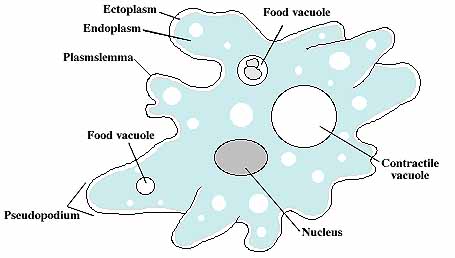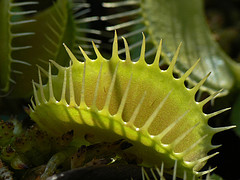Osmoregulation
The maintenance of constant
osmotic pressure in the fluids of an organism by the control of water and salt
concentration known as osmoregulation.
Example: Amoeba
The protoplasm of amoeba has higher concentration than the surrounding fresh water which enters
into the body through endosmosis.
The semi-permeable membrane
helps to receive the water. During the metabolic activities, water in the body
accumulates along with the engusted
food materials. So, the excess of water in the body comes out with a vacuole known as contractile/pulsating vacuole.

When the contractile vacuole is expanded they cannot take any more water
hence water moves to the ectoplasm hence
the pressure is created in the ectoplasm known as ectoplasmic pressure. This pressure leads to bursting of the contractile vacuole resulting in removing the
excess of water. Then the contractile vacuole disappears and new contractile vacuole is formed in the endoplasm.
Note: No specific excretory system in
amoeba.
Nutrition in Animals
The term nutrition
includes the way an organism obtains its food and also possess by which the
nutrients in the food are broken down to simple molecules for the utilization
by the body i.e., intake of nutrients
into the body by an organism known as nutrition.
All living organisms need food to get energy requiring for
growth and to develop the body structure. The chemicals compounds which are
required for body structure and energy production known as nutrients useful to nutrition.
Nutrients may be simple or complex substances like carbohydrates, proteins, fats, vitamins,
minerals and water which gives
energy to the body. These are all obtained through the food they consume.
Note:
Different organisms require different types of food materials.
Ø
Types of
nutrition
The mechanism by which an organism obtains food is referred
as mode of nutrition. The organisms
synthesize their own food or obtain food prepared by other organisms in various
ways.
Basically
they are four modes of nutrition as follows:
·
Autotrophic
nutrition
·
Heterotrophic nutrition.
·
Mixotrophic nutrition.
·
Symbiotic nutrition.
·
Autotrophic
nutrition
The organisms which can synthesize their own
food materials in the presence of sunlight using carbon dioxide known as autotrophs
and the process known as autotrophic
nutrition.
Examples: Plants, Bacteria, Nitrifying bacteria.
6CO2
+ 6H2O ¾® C6H12O6 + 6O2
Photosynthesis
These bacteria can be categorized into two types as follows:
§ Photoautotrophic nutrition
The organisms which can synthesize the food
materials in the presence of light but it is different from the photosynthesis
process of green plants. (Green plants releases O2 but they can’t because water is not
used as a hydrogen donor).For this reason, this process is described as anoxygenic photosynthesis.

§ Chemoautotrophic nutrition
` The organisms which can synthesizes organic compounds
from inorganic compounds utilizing energy liberated from the oxidation of
inorganic substances. The common types of this are as follows:
o
Nitrifying
bacteria which derive energy by oxidizing ammonia into nitrates. Examples:
Nitrosomonas, Nitrobacter.

o
.
Sulphur bacteria which derive energy by oxidising hydrogen sulphide to sulphur.
Examples: Thiobacillus, Beggiatoa.

o
. Iron
Bacteria which derive energy by oxidising ferrous ions into ferric form.
Examples: Ferrobacillus, Gallionella.

·
Heterotrophic
nutrition
The organisms which obtains their food from
other organisms known as hetertrophs
and the process known as heterotrophic
nutrition.
Examples: Fungi,
Animals, Protists .
These are of three types as follows:
§ Holozoic nutrition
The
organisms which takes the food into the body and digest them into smaller
particles with a specialized digestive tract for:
o Indigestion: Taking the food into the
body in the form of complex organic molecules
o Digestion: Breaks the food into micro
molecules in the body.
o Absorption: Takes the soluble digested
materials and absorbs in the body. After absorbing
the digested food, it is utilized by the cells for various metabolic activities in the body.
o Egestion: Removes the undigested food
from the body.
§ Saprozoic nutrition
The organisms which feeds on dead and
decaying matter known as saprozoic
nutrition. The organic substances of this
dissolves by the secretion of exogenous enzymes like glucanase ,xylanase.
Examples: Bacteria, Fungi.
§ Parasitic nutrition
The bacteria which occurs in the body of
animals for obtaining food from there. Most of these cause diseases in the host
organism either by exploiting them
or releasing poisonous secretions called as toxins.
·
Mixotrophic
nutrition
The association between
two different living organisms i.e., food from autotrophs and heterotrophs.
·
Symbiotic
nutrition
When two organisms living together they will
exchange the food substances, of this both are benefited. This type of
nutrition is known as symbiotic nutrition
ü Example: leguminous plants
In these plants, legumes are present which are red
in colour due to the presence of leg
hemoglobin. These nodules consists N2
fixing bacteria known as rhizobium,
which converts atmospheric N2 into nitrates and supply them to the plants and plants gives food and shelter to rhizobium.
Thus, this association between two organisms,
both are benefited is referred as symbiosis and organisms involved in this are
known as symbionts.
Ø
Feeding
habits
On the basis of feeding habits, animals can
be grouped as:
ü Herbivorous: feeds on plants –Deer
ü Carnivorous: feeds on other animals – Lion
ü Omnivorous: feeds on plants and animals
– Cow
ü Scavengers: feeds on dead animals – Vulture
ü Insectivorous: feeds on insects – Lizard
ü Voracious: feeds on larvae of
invertebrates – Gambusia
ü Larvivorous: feeds on larvae – Fish
ü Sanguivorous: feeds on blood – Leech
ü Predators: feeds on lower species – Birds
ü Cannabolism: feeds on own species –
Snakes
ü Detritous: feeds on organic food in
soil – Earthworm
ü Caprophagous: feeds on own faeces – Rabbit
ü Piscivorous: feeds on fishes – Penguins
ü Myrmecophagous: feeds on ants - Bugs
Nutrition in Insectivorous
plants
The plants which captures the
prey items such as insects, spiders, crustaceans, mites and protozoans known as
insectivorous plants.
These plants grow in nitrogen
deficient soils and root system is poorly developed. The leaves of these plants
are modified into trap leaves which secrete proteolytic enzymes to digest the proteins of the prey. These
digested proteins are absorbed by the
leaf surface.
Examples
Ø
Nepenthes
(Pitcher plant)
These plants have elongated tendrils bearing
pitcher traps at their tips. Each pitcher has a thickened rim and a lid at the
apex helps to trap the insects.
Ø
Drosera
(Sundew plant)
These plants have elongated leaf which is
covered with dense, gland-tipped hairs (sticky). If flies falls on that, they
will be slowly, enzymatically digested and obsorbed by the plant.
   
Nepenthes Drosera Utricularia Dionaea
Ø
Utricularia
(Bladder wort)
These are aquatic submerged plant consists of
segmented leaves which are flattened and pear shaped structures (bladder). The
mouth of this consists trap doors helps to trap the insects.
Ø
Dionea (Venus
trap)
These plants have hinged leaves with stiff
hairs which can trap the insects. When the leaf blade folds closed, it traps
the insects by the intermeshed hairs.
| 




